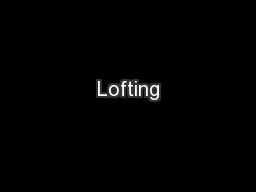PPT-Lofting
Author : tatyana-admore | Published Date : 2017-08-16
AE460 Greg Marien Lecturer Background Ship design history Surfaces with CAD Lofting method is independant of CAD system Solidworks Creo NX etc Loft is also know
Presentation Embed Code
Download Presentation
Download Presentation The PPT/PDF document "Lofting" is the property of its rightful owner. Permission is granted to download and print the materials on this website for personal, non-commercial use only, and to display it on your personal computer provided you do not modify the materials and that you retain all copyright notices contained in the materials. By downloading content from our website, you accept the terms of this agreement.
Lofting: Transcript
Download Rules Of Document
"Lofting"The content belongs to its owner. You may download and print it for personal use, without modification, and keep all copyright notices. By downloading, you agree to these terms.
Related Documents

